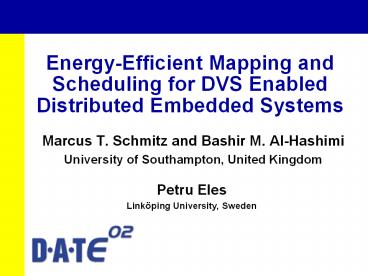Energy-Efficient Mapping and Scheduling for DVS Enabled Distributed Embedded Systems - PowerPoint PPT Presentation
1 / 28
Title:
Energy-Efficient Mapping and Scheduling for DVS Enabled Distributed Embedded Systems
Description:
Energy-Efficient Mapping and Scheduling for DVS Enabled Distributed Embedded Systems Marcus T. Schmitz and Bashir M. Al-Hashimi University of Southampton, United Kingdom – PowerPoint PPT presentation
Number of Views:163
Avg rating:3.0/5.0
Title: Energy-Efficient Mapping and Scheduling for DVS Enabled Distributed Embedded Systems
1
Energy-Efficient Mapping and Scheduling for DVS
Enabled Distributed Embedded Systems
- Marcus T. Schmitz and Bashir M. Al-Hashimi
- University of Southampton, United Kingdom
Petru Eles Linköping University, Sweden
2
Contents
- Motivation Introduction
- Dynamic Voltage Scaling
- Co-Synthesis with DVS Consideration
- DVS optimised Scheduling
- DVS optimised Mapping
- Experimental Results
- Conclusions
3
Motivation
- Low Energy
- Portable Applications
- Autonomous Systems
- Feasibilty Issues (SoC - heat)
- Operational Cost and Environmental Reasons
- System Level Co-Design
- Shrinking Time-To-Market Windows
- Reducing Production Cost
- High Degree of Optimisation Freedom
4
Introduction
Dynamic Voltage Scaling
System Level Co-Synthesis
Energy-Efficient Co-Synthesis for DVS Sytems
5
Dynamic Voltage Scaling (DVS)
Energy vs. Speed
1.2
DVS Processor
1
Frequency
0.8
f Reg.
VR
Energy
0.6
Voltage/Frequency
0.4
0.2
0
1
1.5
2
2.5
3
3.5
4
4.5
5
1/Speed
Available from Transmeta, AMD, Intel
6
Co-Synthesis for DVS Systems
System Specification, Technology Lib.
Allocation
Mapping
Scheduling
Designer driven
EE-GMA
Voltage Scaling
EE-GLSA
Evaluation
7
DVS in Distributed Systems 23
Input Scheduling (mapping) Power profile
Output scaled voltage for each DVS task
Emax
Esc lt Emax
P
P
Slack
PE0
PE0
CL0
CL0
2.3V
2.4V
3.3V
PE1
PE1
d
d
t
t
_at_ Vmax
_at_ dyn. V
8
Energy-Efficient Scheduling
- Two objectives
- Timing feasibility
- Garantee deadlines
- Low energy dissipation
- Optimisation DVS usability Slack time
Traditional scheduling technique focus mainly on
timing feasibility!
- Problem due to power variations
- Simply increase deadline slack leads to
sub-optimal solutions!
9
Energy-Efficient Scheduling
S1
E71?J
E65.6?J
P
P
PE0
t
t
t
t
5
4
4
5
Slack ? Savings ?
DVS
PE1
t
t
t
t
1
1
2
t
2
t
0
0
Slack
PE2
t
3
t
6
t
t
3
6
t
t
S2
E71?J
E53.9?J
P
P
Slack
Slack ? Savings ?
PE0
t
t
5
4
t
t
4
5
DVS
PE1
t
t
t
t
1
1
2
t
2
t
0
0
PE2
t
t
3
3
t
t
6
6
t
t
10
Energy-Efficient Scheduling
- Based on Genetic List Scheduling Algorithm 6,10
- Task priorities are encoded into priorities
strings
Schedule
- Duties of the Scheduler
- Select ready task with highest priority
- Schedule selected task
- Update schedule and ready list
- Repeat until no un-scheduled task is left
PS
4 3 9 7 2
11
EE-GLSA
3
7
8
1
2
3
2
1
3
2
No Hole Filling! No Mapping!
Initial Population
Timing, Energy
Optimised Population
high
low
GA
12
Advantages
- Optimisation can be based on an arbitrary complex
fitness function, including - Timing
- Energy (DVS technique)
- Enlarged search space (TC! different
schedules) - Trade-off freedom Synthesis time lt-gt quality
- Easily adaptable to computing clusters
- Multiple populations with immigration scheme
13
Hole Filling Problem
t0
t4
PE0
t2
7
t3
t3
1
t1
d2
d3,4
4
t4
6
t2
4
PE1
t0
t1
Therefore, priorities decide solely upon
execution order!
14
Task Mapping
- Why seperation from the list scheduling?
- Regardless of priorties, greedy mapping
P
t0
7
PE0
t1
4
PE1
t
t2
d1,2
5
15
Task Mapping
- Make greedy mapping decision based on
- Timing
- Energy
P
t0
7
PE0
?
t1
4
PE1
?
t
t2
d1,2
5
16
Task Mapping
- Make mapping decision based on
- Timing
- Energy
P
t0
7
PE0
t0
t1
4
PE1
t
t2
d1,2
5
17
Task Mapping
- Make mapping decision based on
- Timing
- Energy
P
t0
7
PE0
t0
?
t1
4
PE1
?
t
t2
d1,2
5
18
Task Mapping
- Make mapping decision based on
- Timing
- Energy
P
t0
7
PE0
t0
t1
4
t2
PE1
t
t2
d1,2
5
19
Task Mapping
- Make mapping decision based on
- Timing
- Energy
P
t0
7
PE0
t0
t1
4
t2
PE1
t
t2
d1,2
5
20
Task Mapping
- Make mapping decision based on
- Timing
- Energy
P
t0
7
PE0
t0
t1
4
t2
t1
PE1
t
t2
d1,2
5
21
Task Mapping
- Make mapping decision based on
- Timing
- Energy
P
t0
7
PE0
t0
t2
t1
4
t1
PE1
t
t2
d1,2
5
22
Genetic Mapping Algorithm 8
Task mapping are encoded into mapping strings
task PE
?0 1
?1 0
?2 2
?3 1
?4 1
?5 0
?6 0
Chromosome
23
EE-GMA
Including DVS
EE-GLSA
Initial Population
Timing, Energy Area
Optimised Population
high
low
GA
24
Experimental Results
- 4 Benchmark Sets
- 27 generated by TGFF 7
- 8 to 100 tasks Power variations 2.6
- 2 Hou examples taken from 13
- 8 to 20 tasks Power variations 11
- TG1 and TG2 taken from 11
- 60 examples with 30 tasks, each No power
variations - Measurement application taken from 3
- 12 tasks No power profile is provided
- Power and time overhead for DVS is neglected
- Average results of 5 optimisation runs
25
Schedule Optimisation
26
Schedule Optimisation
27
Mapping Optimisation
28
Conclusions
- DVS capability can achieve high energy savings in
distributed embedded systems - Proposed a new energy-efficient two-step mapping
and scheduling approach - Iterative improvement provides high savings / ad
hoc constructive techniques are not suitable - Optimisation times are reasonable
- Additional objectives can be easily included
- Consideration of power profile information leads
to further energy reductions































